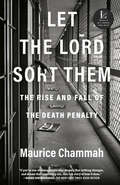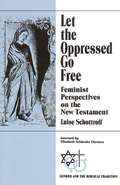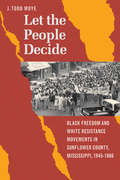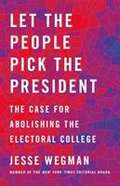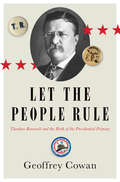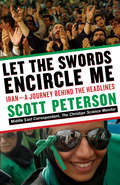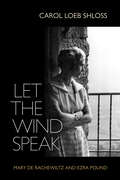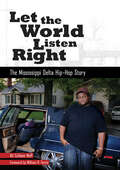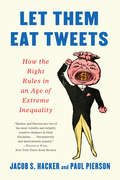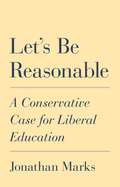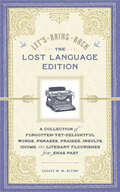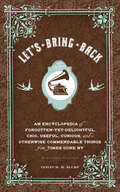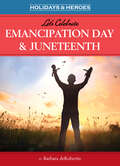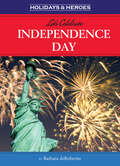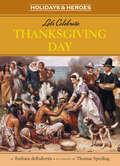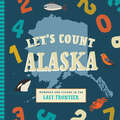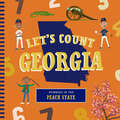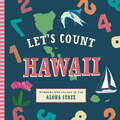- Table View
- List View
Let the Lord Sort Them: The Rise and Fall of the Death Penalty
by Maurice ChammahA deeply reported, searingly honest portrait of the death penalty in Texas—and what it tells us about crime and punishment in America&“Remarkably intimate, fair-minded, and trustworthy reporting on the people arguing over the fate of human life.&”—Robert Kolker, New York Times bestselling author of Hidden Valley Road: Inside the Mind of an American FamilyWINNER OF THE J. ANTHONY LUKAS WORK-IN-PROGRESS AWARDIn 1972, the United States Supreme Court made a surprising ruling: the country's death penalty system violated the Constitution. The backlash was swift, especially in Texas, where executions were considered part of the cultural fabric, and a dark history of lynching was masked by gauzy visions of a tough-on-crime frontier. When executions resumed, Texas quickly became the nationwide leader in carrying out the punishment. Then, amid a larger wave of criminal justice reform, came the death penalty&’s decline, a trend so durable that even in Texas the punishment appears again close to extinction. In Let the Lord Sort Them, Maurice Chammah charts the rise and fall of capital punishment through the eyes of those it touched. We meet Elsa Alcala, the orphaned daughter of a Mexican American family who found her calling as a prosecutor in the nation's death penalty capital, before becoming a judge on the state's highest court. We meet Danalynn Recer, a lawyer who became obsessively devoted to unearthing the life stories of men who committed terrible crimes, and fought for mercy in courtrooms across the state. We meet death row prisoners—many of them once-famous figures like Henry Lee Lucas, Gary Graham, and Karla Faye Tucker—along with their families and the families of their victims. And we meet the executioners, who struggle openly with what society has asked them to do. In tracing these interconnected lives against the rise of mass incarceration in Texas and the country as a whole, Chammah explores what the persistence of the death penalty tells us about forgiveness and retribution, fairness and justice, history and myth.Written with intimacy and grace, Let the Lord Sort Them is the definitive portrait of a particularly American institution.
Let the Meatballs Rest: And Other Stories About Food and Culture (Arts and Traditions of the Table: Perspectives on Culinary History)
by Massimo MontanariKnown for his entertaining investigations into culinary practice, Massimo Montanari turns his hungry eye to the phenomenon of food culture, food lore, cooking methods, and eating habits throughout history. An irresistible buffet of one hundred concise and engaging essays, this collection provides stimulating food for thought for those curious about one of life's most fundamental pleasures.Focusing on the selection, preparation, and mythology of food, Montanari traverses such subjects as the status of the pantry over the centuries, the various strategies of cooking over time, the gastronomy of famine, the science of flavors, the changing characteristics of convivial rituals, the customs of the table, and the ever-evolving identity of food. He shows that cooking not only is a decisive part of our cultural heritage but also communicates essential information about our material and intellectual well-being. From the invention of basic bread making to chocolate's reputation for decadence, Montanari positions food culture as a lens through which we can plot changes in historical values and social and economic trends. Even the biblical tale of Jacob buying Esau's birthright for a bowl of lentils is a text full of essential meaning, representing civilization's important shift from a hunting to an agrarian society. Readers of all backgrounds will enjoy these delectable insights and their easy consumption in one companionable volume.
Let the Monster Perish: The Historic Address To Congress Of Henry Highland Garnet
by Henry Highland GarnetLet the Oppressed Go Free: Feminist Perspectives on the New Testament
by Luise Schottroff Annamarie S. KidderThis book draws together fascinating recent studies by a leading European scholar of aspects of the New Testament of special interest to women. These essays, translated for the first time, will deepen feminist scholarship in the English-speaking world.
Let the People Decide
by J. Todd MoyeIn the middle of the Mississippi Delta lies rural, black-majority Sunflower County. J. Todd Moye examines the social histories of civil rights and white resistance movements in Sunflower, tracing the development of organizing strategies in separate racial communities over four decades. Sunflower County was home to both James Eastland, one of the most powerful reactionaries in the U.S. Senate in the twentieth century, and Fannie Lou Hamer, the freedom-fighting sharecropper who rose to national prominence as head of the Mississippi Freedom Democratic Party. Sunflower was the birthplace of the Citizens' Council, the white South's pre-eminent anti-civil rights organization, but it was also a hotbed of SNCC (Student Nonviolent Coordinating Committee) organizing and a fountainhead of freedom culture.Using extensive oral history interviews and archival research, Moye situates the struggle for democracy in Sunflower County within the context of national developments in the civil rights movement. Arguing that the civil rights movement cannot be understood as a national monolith, Moye reframes it as the accumulation of thousands of local movements, each with specific goals and strategies. By continuing the analysis into the 1980s, Let the People Decide pushes the boundaries of conventional periodization, recognizing the full extent of the civil rights movement.
Let the People Pick the President: The Case for Abolishing the Electoral College
by Jesse WegmanThe framers of the Constitution battled over it. Lawmakers have tried to amend or abolish it more than 700 times. To this day, millions of voters, and even members of Congress, misunderstand how it works. It deepens our national divide and distorts the core democratic principles of political equality and majority rule. How can we tolerate the Electoral College when every vote does not count the same, and the candidate who gets the most votes can lose? Twice in the last five elections, the Electoral College has overridden the popular vote, calling the integrity of the entire system into question--and creating a false picture of a country divided into bright red and blue blocks when in fact we are purple from coast to coast. Even when the popular-vote winner becomes president, tens of millions of Americans--Republicans and Democrats alike--find that their votes didn't matter. And, with statewide winner-take-all rules, only a handful of battleground states ultimately decide who will become president. Now, as political passions reach a boiling point at the dawn of the 2020 race, the message from the American people is clear: The way we vote for the only official whose job it is to represent all Americans is neither fair nor just. Major reform is needed--now. Isn't it time to let the people pick the president? In this thoroughly researched and engaging call to arms, Supreme Court journalist and New York Times editorial board member Jesse Wegman draws upon the history of the founding era, as well as information gleaned from campaign managers, field directors, and other officials from twenty-first-century Democratic and Republican presidential campaigns, to make a powerful case for abolishing the antiquated and antidemocratic Electoral College. In Let the People Pick the President he shows how we can at long last make every vote in the United States count--and restore belief in our democratic system.
Let the People Rule: Theodore Roosevelt and the Birth of the Presidential Primary
by Geoffrey CowanThe exhilarating, prescient story of the four-month campaign that changed American politics forever. Let the People Rule tells the exhilarating story of the four-month campaign that changed American politics forever. In 1912 Theodore Roosevelt came out of retirement to challenge his close friend and handpicked successor, William Howard Taft, for the Republican Party nomination. To overcome the power of the incumbent, TR seized on the idea of presidential primaries, telling bosses everywhere to “Let the People Rule.” The cheers and jeers of rowdy supporters and detractors echo from Geoffrey Cowan’s pages as he explores TR’s fight-to-the-finish battle to win popular support. After sweeping nine out of thirteen primaries, he felt entitled to the nomination. But the party bosses proved too powerful, leading Roosevelt to walk out of the convention and create a new political party of his own. Using a trove of newly discovered documents, Cowan takes readers inside the colorful, dramatic, and often mean-spirited campaign, describing the political machinations and intrigue and painting indelible portraits of its larger-than-life characters. But Cowan also exposes the more unsavory parts of TR’s campaign: seamy backroom deals, bribes made in TR’s name during the Republican Convention, and then the shocking political calculation that led TR to ban any black delegates from the Deep South from his new “Bull Moose Party.” In this utterly compelling work, Cowan illuminates lessons of the past that have great resonance for American politics today.
Let the Students Speak! A History of the Fight for Free Expression in American Schools
by David L. Hudson Jr.From a trusted scholar and powerful story teller, an accessible and lively history of free speech, for and about students. Let the Students Speak! details the rich history and growth of the First Amendment in public schools, from the early nineteenth-century's failed student free-expression claims to the development of protection for students by the U.S. Supreme Court. David Hudson brings this history vividly alive by drawing from interviews with key student litigants in famous cases, including John Tinker of Tinker v. Des Moines Independent School District and Joe Frederick of the "Bong Hits 4 Jesus" case, Morse v. Frederick. He goes on to discuss the raging free-speech controversies in public schools today, including dress codes and uniforms, cyberbullying, and the regulation of any violent-themed expression in a post-Columbine and Virginia Tech environment. This book should be required reading for students, teachers, and school administrators alike.
Let the Swords Encircle Me: Iran--a Journey Behind the Headlines
by Scott PetersonAn American author with vast experience in Iran takes us into the minds and hearts of Iranians today.
Let the Wind Speak: Mary de Rachewiltz and Ezra Pound
by Carol ShlossCarol Loeb Shloss creates a compelling portrait of a complex relationship of a daughter and her literary-giant father: Ezra Pound and Mary de Rachewiltz, Pound’s child by his long-time mistress, the violinist Olga Rudge. Brought into the world in secret and hidden in the Italian Alps at birth, Mary was raised by German peasant farmers, had Italian identity papers, a German-speaking upbringing, Austrian loyalties common to the area and, perforce, a fascist education.For years, de Rachewiltz had no idea that Pound and Rudge, the benefactors who would sporadically appear, were her father and mother. Gradually the truth of her parentage was revealed, and with it the knowledge that Dorothy Shakespear, and not Olga, was Pound’s actual wife. Dorothy, in turn, kept her own secrets: while Pound signed the birth certificate of her son, Omar, and claimed legal paternity, he was not the boy’s biological father. Two lies, established at the birth of these children, created a dynamic antagonism that lasted for generations.Pound maneuvered through it until he was arrested for treason after World War II and shipped back from Italy to the United States, where he was institutionalized rather than imprisoned. As an adult, de Rachewiltz took on the task of claiming a contested heritage and securing her father’s literary legacy in the face of a legal system that failed to recognize her legitimacy. Born on different continents, separated by nationality, related by natural birth, and torn apart by conflict between Italy and America, Mary and Ezra Pound found a way to live out their deep and abiding love for one another.Let the Wind Speak is both a history of modern writers who were forced to negotiate allegiances to one another and to their adopted countries in a time of mortal conflict, and the story of Mary de Rachewiltz’s navigation through issues of personal identity amid the shifting politics of western nations in peace and war. It is a masterful biography that asks us to consider cultures of secrecy, frayed allegiances, and the boundaries that define nations, families, and politics.
Let the World Listen Right: The Mississippi Delta Hip-Hop Story (American Made Music Series)
by Ali Colleen NeffIn the Mississippi Delta, creativity, community, and a rich expressive culture persist despite widespread poverty. Over five years of extensive work in the region, author Ali Colleen Neff collected a wealth of materials that demonstrate a vibrant musical scene. Let the World Listen Right draws from classic studies of the blues as well as extensive ethnographic work to document the “changing same” of Delta music making. From the neighborhood juke joints of the contemporary Delta to the international hip-hop stage, this study traces the musical networks that join the region's African American communities to both traditional forms and new global styles. The book features the words and describes performances of contemporary artists, including blues musicians, gospel singers, radio and club DJs, barroom toast-tellers, preachers, poets, and a spectrum of Delta hip-hop artists. Contemporary Delta hip-hop artists Jerome “TopNotch the Villain” Williams, Kimyata “Yata” Dear, and DA F.A.M. have contributed freestyle poetry, extensive interview materials, and their own commentaries. The book focuses particularly on the biography of TopNotch, whose hip-hop poetics emerge from a lifetime of schoolyard dozens and training in the gospel church.
Let them Eat Tweets: How The Right Rules In An Age Of Extreme Inequality
by Jacob S. Hacker Paul PiersonA New York Times Editors’ Choice An “essential” (Jane Mayer) account of the dangerous marriage of plutocratic economic priorities and right-wing populist appeals — and how it threatens the pillars of American democracy. In Let Them Eat Tweets, best-selling political scientists Jacob S. Hacker and Paul Pierson argue that despite the rhetoric of Donald Trump, Josh Hawley, and other right-wing “populists,” the Republican Party came to serve its plutocratic masters to a degree without precedent in modern global history. To maintain power while serving the 0.1 percent, the GOP has relied on increasingly incendiary racial and cultural appeals to its almost entirely white base. Calling this dangerous hybrid “plutocratic populism,” Hacker and Pierson show how, over the last forty years, reactionary plutocrats and right-wing populists have become the two faces of a party that now actively undermines democracy to achieve its goals against the will of the majority of Americans. Based on decades of research and featuring a new epilogue about the intensification of GOP radicalism after the 2020 election, Let Them Eat Tweets authoritatively explains the doom loop of tax cutting and fearmongering that defines the Republican Party—and reveals how the rest of us can fight back.
Let's Be Reasonable: A Conservative Case for Liberal Education
by Jonathan MarksA conservative college professor's compelling defense of liberal educationNot so long ago, conservative intellectuals such as William F. Buckley Jr. believed universities were worth fighting for. Today, conservatives seem more inclined to burn them down. In Let's Be Reasonable, conservative political theorist and professor Jonathan Marks finds in liberal education an antidote to this despair, arguing that the true purpose of college is to encourage people to be reasonable—and revealing why the health of our democracy is at stake.Drawing on the ideas of John Locke and other thinkers, Marks presents the case for why, now more than ever, conservatives must not give up on higher education. He recognizes that professors and administrators frequently adopt the language and priorities of the left, but he explains why conservative nightmare visions of liberal persecution and indoctrination bear little resemblance to what actually goes on in college classrooms. Marks examines why advocates for liberal education struggle to offer a coherent defense of themselves against their conservative critics, and demonstrates why such a defense must rest on the cultivation of reason and of pride in being reasonable.More than just a campus battlefield guide, Let's Be Reasonable recovers what is truly liberal about liberal education—the ability to reason for oneself and with others—and shows why the liberally educated person considers reason to be more than just a tool for scoring political points.
Let's Bring Back: A Collection of Forgotten-Yet-Delightful Words, Phrases, Praises, Insults, Idioms, and Literary Flourishes from Eras Past
by Lesley M. BlumeAn A-to-Z reference featuring wonderful words and expressions from the past: “What a fun book!” —Kathleen Dunn, Wisconsin Public RadioHistory is positively brimming with rich language deserving of rejuvenation. This compendium gathers forgotten words, phrases, names, insults, and idioms, plus fascinating and funny anecdotes, etymologies, and occasions for modern use. Let’s Bring Back: The Lost Language Edition takes readers on a philological journey through words from the not-too-distant past. From all-overish to zounds, the vintage vernacular collected here will make any reader the cat’s meow among friends, relations, and acquaintances.
Let's Bring Back: An Encyclopedia of Forgotten-Yet-Delightful, Chic, Useful, Curious, and Otherwise Commendable Things from Times Gone By
by Lesley M. BlumeAn illustrated A-to-Z tribute to old-fashioned items worth rediscovering: “Wistful . . . charming . . . like a stroll down memory lane.” —ElleWhatever happened to cuckoo clocks? Or bed curtains? Why do we have so many “friends” while doing away with the much more useful word “acquaintance”? All of these things, plus hot toddies, riddles, proverbs, corsets, calling cards, and many more, are due for a revival. Throughout this whimsical, beautifully illustrated encyclopedia of nostalgia, Lesley M.M. Blume breathes new life into the elegant, mysterious, and delightful trappings of bygone eras, honoring the timeless tradition of artful living along the way. Inspired by her much loved Huffington Post column of the same name and featuring entries from famous icons of style and culture, Let’s Bring Back leads readers to rediscover the things that entertained, awed, beautified, satiated, and fascinated in eras past.“Witty . . . recommended reading.” —Country Living“If you’re feeling lousy and you read this book, it awakens you to things that have made you happy in your life. It reminds you of a time when certain things ideas, gestures got you through . . . and revels in an idea of life that’s lived in 3-D, not 2-D.” —Sally Singer, editor, T: The New York Times Magazine
Let's Call Her Barbie
by Renée Rosen&“A fresh and fun take on Barbie lore…clever and satisfying.&” – Shelby Van Pelt, #1 New York Times bestselling author of Remarkably Bright CreaturesShe was only eleven-and-a-half inches tall, but she would change the world. Barbie is born in this bold new novel by USA Today bestselling author Renée Rosen.When Ruth Handler walks into the boardroom of the toy company she co-founded and pitches her idea for a doll unlike any other, she knows what she&’s setting in motion. It might just take the world a moment to catch up.In 1956, the only dolls on the market for little girls let them pretend to be mothers. Ruth&’s vision for a doll shaped like a grown woman and outfitted in an enviable wardrobe will let them dream they can be anything.As Ruth assembles her team of creative rebels—head engineer Jack Ryan who hides his deepest secrets behind his genius and designers Charlotte Johnson and Stevie Klein, whose hopes and dreams rest on the success of Barbie&’s fashion—she knows they&’re working against a ticking clock to get this wild idea off the ground.In the decades to come—through soaring heights and devastating personal lows, public scandals and private tensions— each of them will have to decide how tightly to hold on to their creation. Because Barbie has never been just a doll—she&’s a legacy.Includes a Readers Guide and Exclusive Vintage Barbie Photos!
Let's Celebrate Columbus Day (Holidays & Heros)
by Barbara deRubertisThis is the story of the famous explorer Christopher Columbus, beginning with his childhood dream of being a sailor. A courageous, determined, and sometimes greedy man, his many voyages never brought him the riches or land he sought, but what he did find was more important than he ever could have imagined.
Let's Celebrate Emancipation Day & Juneteenth (Holidays & Heros)
by Barbara deRubertisHOLIDAYS & HEROES brings to life the people whose holidays we celebrate. Enriched with colorful illustrations, photographs, and other historical images, this series will engage and involve children in the stories behind our holidays and the people they honor.In the 1800s, abolitionists like Harriet Tubman, Frederick Douglass, and Sojourner Truth fought for freedom from slavery for all African Americans. They fought with speeches, songs, newspapers, and even with daring rescue missions! Every year on both Emancipation Day and Juneteenth we honor and continue their fight for freedom and equality.
Let's Celebrate Independence Day (Holidays & Heros)
by Barbara deRubertisHOLIDAYS & HEROES brings to life the people whose holidays we celebrate. Enriched with colorful illustrations, photographs, and other historical images, this series will engage and involve children in the stories behind our holidays and the people they honor.Every 4th of July, we celebrate the United States of America, the &“land of the free.&” Learn the story of our country&’s beginnings and how our courageous Founding Fathers broke away from royal rule with the Declaration of Independence.
Let's Celebrate Memorial Day (Holidays & Heros)
by Barbara deRubertisHOLIDAYS & HEROES brings to life the people whose holidays we celebrate. Enriched with colorful illustrations, photographs, and other historical images, this series will engage and involve children in the stories behind our holidays and the people they honor.On the last Monday of May, when spring flowers are in bloom and summer is just around the corner, we pause to remember all the people in our Armed Forces who died while protecting our country, our freedoms, and us.
Let's Celebrate Thanksgiving Day (Holidays & Heros)
by Barbara deRubertisThe passing seasons are used as a vehicle to tell the parallel stories of the Wampanoag and the Pilgrims, from the European settlers' landing in 1620 through the first Thanksgiving feast in November of 1621.
Let's Celebrate Veterans Day (Holidays & Heros)
by Barbara deRubertisWho is a veteran? By exploring the kinds of work that men and women do as they serve in the five branches of the military, we can better appreciate our veterans. And we discover some of the many reasons we honor and celebrate them each year on November 11.
Let's Count Alaska
by Trish MadsonNumbers and colors are more fun in Alaska! In this dynamic, colorful primer, young readers count from 1 to 10—learning colors along the way—as they discover the places, animals, and other wonderful things that make Alaska so unique.
Let's Count Georgia
by Christopher Robbins1 green jacket at the Masters won 2 favorite players hit a home run 3 pretty dogwoods in springtime bloom 4 Civil War cannons sound a boom Numbers and colors are more fun in Georgia! In this dynamic, colorful primer, young readers count from 1 to 10—learning colors along the way—as they discover the places, animals, and other wonderful things that make Georgia so unique.
Let's Count Hawaii
by Trish Madson1 red ukulele plays a tropical tune.2 yellow hibiscus flowers beautifully in bloom.3 brown coconuts hang on a palm tree.4 blue marlin swim deep in the sea.Numbers and colors are more fun in Hawaii! In this dynamic, colorful primer, young readers count from 1 to 10, learning about colors along the way as they discover the places, animals, and other wonderful things that make Hawaii so unique!
